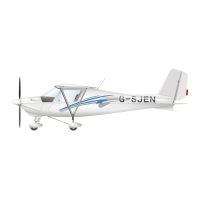
Do you have a question about the iKarus C42 Series and is the answer not in the manual?
| Manufacturer | Comco Ikarus |
|---|---|
| Type | Light sport aircraft |
| Maximum takeoff weight | 472.5 kg (1, 042 lb) |
| Engine | Rotax 912 |
| Horsepower | 80 hp (60 kW) |
| Cruise speed | 160 km/h |
| Range | 800 km |
| Service ceiling | 4, 000 m |
| Stall speed | 65 km/h |
| Rate of climb | 5 m/s |
Provides general information on the handbook, aircraft certification, and usage guidelines.
Details the history of revisions made to the Pilot's Operating Handbook.
Lists contact details for the manufacturer (COMCO IKARUS) and distributor (DKL Light Sport Aircraft).
Details the aircraft's certification as Microlight, Ultralight, etc., and pilot licensing requirements.
Covers pilot responsibility, engine notes, prohibited modifications, and general safety rules.
Provides three-view drawings with dimensions for the IKARUS C42 (C42A) model.
Provides three-view drawings with dimensions for the IKARUS C42B model.
Provides three-view drawings with dimensions for the IKARUS C42C model.
Provides three-view drawings with dimensions for the IKARUS C42CS model.
Details never-exceed speeds, stall speeds, and aircraft weight limits.
Covers load factors, center of gravity limits, and airspeed indicator markings.
Specifies engine RPM limitations and maximum speeds for flap settings.
Lists approved propellers for the ROTAX 912 UL engine with performance data.
Lists approved propellers for the ROTAX 912 ULS engine with performance data.
Presents noise levels (dB A) for various propellers with the ROTAX 912 UL engine.
Presents noise levels (dB A) for various propellers with the ROTAX 912 ULS engine.
Details engine power output and RPM for takeoff, continuous, and other operational phases.
Specifies oil type, quantity, pressure, fuel types, and temperature limits.
Outlines restrictions on aerobatics, flight conditions, and maneuvers.
Provides instructions for starting the engine, warm-up, and cowl flap operation.
Covers taxiing, takeoff procedures, climb, and engine failure during takeoff.
Details cruise speeds, carburetor icing, turns, and stall characteristics.
Describes approach and landing procedures and engine shutdown steps.
Instructions for engine power loss during takeoff, cruise, and engine restart in flight.
Procedures for stalling, spin, spiral dive, and loss of control surfaces.
Covers carburetor fire procedures and parachute deployment instructions.
Details the operation of the optional cowl flap for engine temperature management.
Describes manual maneuvering, suspension, and hoisting procedures for the aircraft.
Covers parking procedures, tie-down methods, and relevant safety precautions.
Lists minimum required equipment and references aircraft dimensions.
Explains calculation of center of gravity and loading plan.
Summarizes key performance data, limitations, and identification from the data placard.
Provides a comprehensive checklist to be completed before takeoff.
Lists approved engines (ROTAX) and compatible propellers.
Details approved parachute rescue systems, fuel tanks, and other diverse equipment.
Presents data on takeoff distances and climb rates for different engine types.
Provides cruise speeds, maximum range, and engine-out glide performance data.
Step-by-step instructions for attaching the wings to the aircraft fuselage.
Details checks for wing attachment security and connections of control surfaces.
Provides procedures for folding the aircraft wings for storage or hangaring.
Covers pre-flight inspection points for the engine and main landing gear.
Details pre-flight inspection points for the wings and fuselage exterior.
Lists pre-flight checks for the empennage, instruments, and drainage systems.
Provides guidance on aircraft cleaning, care, and minor fabric repairs.
Covers repair limitations, periodical inspection requirements, and technical problem reporting.
Details wingspan, wing area, wing chord, dihedral, and stabilizer angles.
Specifies deflection angles for ailerons, rudder, elevator, and flaps.
Provides landing gear pressures, brake system types, and engine service information.
Details components and assembly instructions for handicapped pilot controls.
Explains the operation of handicapped controls during takeoff and landing.
Covers conditions for flying without doors and instructions for LiFe battery usage.
Details LiFe battery preheating, charging, and overvoltage protection.
Outlines warranty terms, coverage, and the process for service claims.
Details the procedure for making a warranty claim and required documentation.
Lists specific conditions and damages not covered by the manufacturer's warranty.
Lists placard locations and content of the aircraft's data placard.
Includes a form for reporting service problems and a log for inspections performed.
Shows the location of the parachute rescue system and exit opening diagrams.
Presents the aircraft's electrical wiring diagram.
